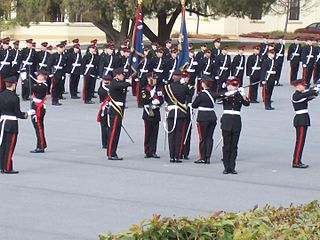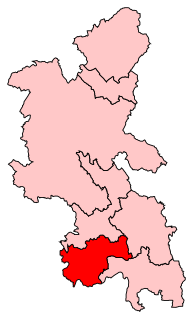

The Royal Military College, High Wycombe was a military training facility for British Army officers in High Wycombe in Buckinghamshire.


The Royal Military College, High Wycombe was a military training facility for British Army officers in High Wycombe in Buckinghamshire.
The college was founded by Colonel John Le Marchant at the Antelope Inn in 1799 as a facility for training junior officers in the British Army who aspired to staff duties. [1] Training was provided in trigonometry, geometry, French language and siege warfare. [2] The facilities proved too small and the institution moved to a building in West Street in Farnham in 1813 before being redesignated the Senior Division of the Royal Military College, Sandhurst in 1820 and then becoming the Staff College, Camberley in 1858. [3]

A military academy or service academy is an educational institution which prepares candidates for service in the officer corps. It normally provides education in a military environment, the exact definition depending on the country concerned.

Brigade of Gurkhas is the collective name which refers to all the units in the British Army that are composed of Nepalese Gurkha soldiers. The brigade, which was 3,430 strong as of 1 April 2019, draws its heritage from Gurkha units that originally served in the British Indian Army prior to Indian independence, and prior to that served for the East India Company. The brigade includes infantry, engineering, signal, logistic and training and support units. They are known for their khukuri, a distinctive heavy knife with a curved blade, and have a reputation for being fierce and brave soldiers.

The Royal Military Academy Sandhurst, commonly known simply as Sandhurst, is one of several military academies of the United Kingdom and is the British Army's initial officer training centre. It is located in the town of Sandhurst, Berkshire, though its ceremonial entrance is in Camberley, southwest of London. The Academy's stated aim is to be "the national centre of excellence for leadership". All British Army officers, including late-entry officers who were previously Warrant Officers, as well as other men and women from overseas, are trained at The Academy. Sandhurst is the British Army equivalent of the Britannia Royal Naval College and the Royal Air Force College Cranwell. Some graduates of these military academies receive further education at the Defence Academy of the United Kingdom.

The Royal Military College (RMC), founded in 1801 and established in 1802 at Great Marlow and High Wycombe in Buckinghamshire, England, but moved in October 1812 to Sandhurst, Berkshire, was a British Army military academy for training infantry and cavalry officers of the British and Indian Armies.

The Royal Military College, Duntroon, also known simply as Duntroon, is the Australian Army's officer training establishment. It was founded at Duntroon, in Canberra, Australian Capital Territory, in 1911 and is located at the foot of Mount Pleasant near Lake Burley Griffin, close to the Department of Defence headquarters at Russell Hill. It is comparable with the United Kingdom's Royal Military Academy Sandhurst and the United States Military Academy at West Point. Duntroon is adjacent to the Australian Defence Force Academy (ADFA), which is Australian Defence Force's tri-service military academy that provides military and tertiary academic education for junior officers of the Australian Army, Royal Australian Air Force and the Royal Australian Navy.

Buckinghamshire New University, styled Bucks New University, is a public university with campuses in High Wycombe, Buckinghamshire; Aylesbury, Buckinghamshire; Uxbridge, Greater London; and Great Missenden, Buckinghamshire. The Vice-Chancellor of the University is Professor Nick Braisby. The institution dates from 1891 when it was founded as the School of Science and Art, and has since that date been re-invented variously as the Wycombe Technical Institute, the High Wycombe College of Technology and Art, and the Buckinghamshire College of Higher Education. It was a university college from 1999 until 2007 when it announced that its application for university status had been accepted.

Major General Robert Keith Arbuthnott, 15th Viscount of Arbuthnott, was a senior British Army officer who served in both the First World War and the Second World War.

Wycombe is a constituency represented in the House of Commons of the UK Parliament since 2010 by Steve Baker, a Conservative.

The Rashtriya Indian Military College (RIMC) is a military school for boys situated in Doon Valley, Dehradun in India. The RIMC is a feeder institution for the National Defence Academy, Indian Naval Academy and subsequently the Indian Armed Forces. Rimcollians, the name by which alumni of the RIMC are usually denoted, have gone on to hold the highest ranks in the Army, Navy and the Air Force of India and Pakistan.
Major-General Hugh Anthony Prince CBE was an Indian Army and British Army officer who became Chief of the Military Planning Office for the Southeast Asia Treaty Organization.
Wycombe was, from 1894 to 1974, a rural district in the administrative county of Buckinghamshire, England.

Staff College, Camberley, Surrey, was a staff college for the British Army and the presidency armies of British India. It had its origins in the Royal Military College, High Wycombe founded in 1799, which in 1802 became the Senior Department of the new Royal Military College. In 1858 the name of the Senior Department was changed to "Staff College", and in 1870 this was separated from the Royal Military College. Apart from periods of closure during major wars, the Staff College continued to operate until 1997, when it was merged into the new Joint Services Command and Staff College. The equivalent in the Royal Navy was the Royal Naval Staff College, Greenwich and the equivalent in the Royal Air Force was the RAF Staff College, Bracknell.

The Royal Air Force College (RAFC) is the Royal Air Force training and education academy which provides initial training to all RAF personnel who are preparing to be commissioned officers. The College also provides initial training to aircrew cadets and is responsible for all RAF recruiting along with officer and aircrew selection. Originally established as a naval aviation training centre during World War I, the College was established as the world's first air academy in 1919. During World War II, the College was closed and its facilities were used as a flying training school. Reopening after the War, the College absorbed the Royal Air Force Technical College in 1966.
Mons Officer Cadet School was a former British military training establishment in Aldershot.

Camberley Obelisk is a brick tower at the top of a hill in Camberley, Surrey, England. The tower was built by John Norris (1721–1786) in about 1765–1770. The top section of the tower was destroyed by fire in the early 1880s. It is a Grade II listed building.
Brigadier Cecil Arthur Harrop Chadwick, was a British soldier and briefly a Liberal Party politician.

Remnantz is a country house in Marlow in Buckinghamshire. It is listed Grade II* on the National Heritage List for England.

Major General Paul Anthony Edward Nanson is a British Army officer who served as Commandant of the Royal Military Academy Sandhurst and is now General Officer Commanding Recruiting and Initial Training Command.
Colonel Lucy Giles is an officer of the British Army's Royal Logistics Corps and the first female College Commander at the Royal Military Academy Sandhurst commanding New College where Officer Cadets spend the second and third terms of the 44-week, 3-term Commissioning Course.

Newland Park is a Grade II listed country house and estate near the village of Chalfont St Peter in Buckinghamshire.